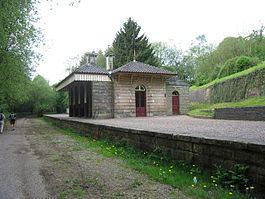Platforms in use 3 | ||
 | ||
Post-grouping LMSLondon Midland Region Similar Stoke‑on‑Trent railway station, Derby railway station, Alton Towers, Alton railway station, Oakamoor railway station | ||
Alton Towers railway station is a disused railway station in the village of Alton, Staffordshire, England.
Contents
The station was on the North Staffordshire Railway's Churnet Valley Line from Macclesfield to Uttoxeter.
History
At the height of the so-called "Railway Mania", when railways were being built across the whole country, the North Staffordshire Railway obtained Parliament's permission to build a number of lines, one of which was the Churnet Valley Line, on 26 June 1845. It ran from North Rode in Cheshire to Uttoxeter in East Staffordshire. A temporary station was erected in Alton which opened on 13 July 1849, and the permanent station buildings opened the following year. The station's design followed an Italianate villa style, unique in this respect among all NSR stations, which were a Tudor or Jacobean style. The architecture is variously attributed to A.W. Pugin and Henry Arthur Hunt, the latter of whom designed most of the NSR's stations.
Early passengers included many day visitors coming in large numbers from the Staffordshire Potteries to visit nearby Alton Towers, the country estate of the Earl of Shrewsbury. A luggage lift was installed to hoist the Earl's baggage up to Alton Towers. The station also comprised a three-storey tower which contained the Earl's suite of waiting rooms and its platform was made particularly long to satisfy the Earl's desire to have impressive surroundings in which to receive his guests.
Several additions were made during the 1880s:
The station experienced a great increase in use from 1924, when Alton Towers was sold to become a tourist attraction, with its gardens and parts of the house open for public use, although it did not become a theme park for several decades afterwards. It became part of the London, Midland and Scottish Railway during the Grouping of 1923. The station then passed on to the London Midland Region of British Railways on nationalisation in 1948, and thereafter the line began to decline. In January 1954, the station was renamed Alton Towers in recognition of its previous service to the Alton Towers estate. Passenger service was greatly reduced from 1960, with eventual closure by the British Railways Board occurring ten years after the renaming. Vandalism of the waiting room became a problem soon thereafter, and the station buildings, platform and sections of line were purchased by Staffordshire County Council in 1969.
The site today
The station buildings, which are grade II listed, were acquired by the Landmark Trust and the stationmaster's house converted into holiday accommodation, opening in 1972. In 2008 the Landmark Trust converted the waiting-room to provide additional accommodation space. The buildings are occasionally open to the public as part of an "Open Day" scheme run by the Trust.
